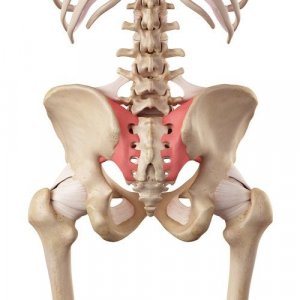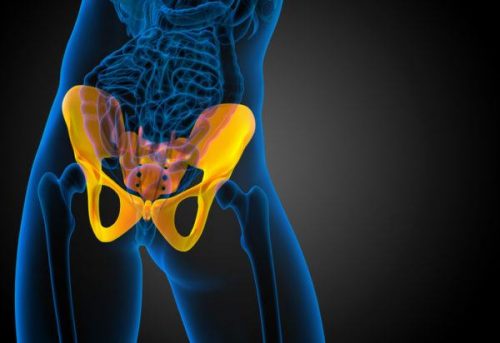Sacroiliac Joint Hypermobility - What Is It?

The sacroiliac joint is below the lumbar spine next to the lower part of the spine, above the coccyx. It’s a structure that connects the sacral bone, which is a triangular bone in the lower part of the spine, with the pelvis (iliac crest).
Both sacroiliac joint hypermobility and other conditions that affect it are usually more frequent in young and middle-aged women.
The sacroiliac joint has the following characteristics:
- Firstly, it’s small, very strong, and reinforced by ligaments
- It doesn’t have a lot of mobility
- It transmits all the forces from the upper body to the hip and legs
- And, finally, it acts as a shock absorber.
Anatomy of the sacroiliac joint

The pelvis comprises the base of the torso, supports the abdomen, and acts like a union between the lower limbs and the torso. Thus, it’s a closed osteoarticular ring composed of three bones and three joints.
The three bones are:
- Two even and symmetrical iliac bones
- The sacred, odd and symmetrical bones
- The vertebral block formed by the fusion of 5 sacral vertebrae.
The pelvis is very important in the unstable balance of the spine since any disagreement in the first will inevitably affect the second. It’s for this reason that we could consider it a functional unit.
Sacroiliac joints are the relief between the spine (above), which is flexible, and the stability of the pelvis below. In addition, scientists consider the sacrum a part of the lumbar vertebrae and the iliac a part of the lower limbs.
Causes of sacroiliac joint pain
It isn’t yet clear why pain occurs in this area. However, some believe that a change in the normal movement of the joint may be to blame for sacroiliac pain.
The source of pain may be due to:
- Sacroiliac joint hypermobility: This happens when there’s too much movement and also instability in this area of the back. People usually feel the pain in the lower part or in the hip and it can radiate to the groin area.
- Sacroiliac joint hypomobility: As opposed to the previous situation, this one occurs when there’s very little movement or fixation of this area. Thus, people usually feel pain on the side of the lower back or buttocks. Also, the pain can radiate down the leg in this case.
You may also be interested in reading: 5 of the Most Common Hip Issues
In fact, people describe this kind of pain as similar to sciatica, which is caused by radiculopathy.
Evaluation of the sacroiliac joint

In addition, the same test can produce different results. You should note that the need for an anamnesis before such tests is also important because it helps the professional to guide you towards this type of examination.
Some of the most common diagnostic tests are:
- Mobility test of the sacroiliac joint: Despite being quite general, a doctor should consider this initial test to evaluate the joint. This is because it provides them with information on mobility within the structure.
- Downing test: This one serves to establish the different lesions and the difference between the total or partial mobility deficit of the iliac bones in the sacrum. In fact, this test consists of two separate ones:
- The elongation test
- The shortening test
- Sacrum to ventral sliding: This technique can detect a blockage of the joint and other symptoms that a person may suffer during the maneuver.
- Gillet hip flexion test: With this maneuver, a doctor can diagnose either a fixation in the ilium or fixation of the sacrum.
Treatments
There are different physiotherapeutic techniques to treat joint problems in this area such as:
- Joint unlocking
- Landslides
- Stretching exercises
- Reorganization of the neuromuscular chains
Postural care
Read also: 5 Exercises to Care for Your Bones
In addition to the aforementioned measures, there are other measures a person can use such as applying ice, heat, and rest. They can also use medications against pain, supports, correctors and controlled physical exercise.
However, you must go to the doctor if you feel discomfort in this area and don’t take any corrective action without their supervision.
All cited sources were thoroughly reviewed by our team to ensure their quality, reliability, currency, and validity. The bibliography of this article was considered reliable and of academic or scientific accuracy.
- Mejía, G. E., Arias, M., Valdez, K., Carrillo, S., & Infante, G. (2008). Dolor de la articulación sacroilíaca. Anatomía, diagnóstico y tratamiento. Revista de La Sociedad Espanola Del Dolor.
- Ramirez, C. (2007). Disfunción de la articulación sacro ilíaca: causa potencial de dolor lumbar. SaludUIS.
- Cánovas Martínez, L., Orduña Valls, J., Paramés Mosquera, E., Lamelas Rodríguez, L., Rojas Gil, S., & Domínguez García, M. (2016). Sacroiliac joint pain: Prospective, randomised, experimental and comparative study of thermal radiofrequency with sacroiliac joint block. Revista Española de Anestesiología y Reanimación (English Edition). https://doi.org/10.1016/j.redare.2015.12.001.
This text is provided for informational purposes only and does not replace consultation with a professional. If in doubt, consult your specialist.









